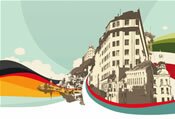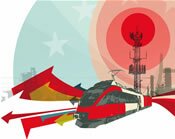Inflight Magazine of Brussels Airlines
Welcome to the Inflight Magazine of Brussels Airlines
Waltz this way
Illustration Paolo/ www.illustrationroom.com.au
Last year saw a record level of foreign direct investment in Vienna. Boyd Farrow takes a look at why Austria is proving such a powerful magnet for foreign investors
 For two weeks in May this year, the medieval Austrian town of Bregenz was besieged by trucks and North Face-wearing men and women talking into their pockets or lugging cables. Bregenz’s opera festival plays a key role in the new Bond film Quantum of Solace, and as camera operators readied an extravagant chase sequence involving 007 and Lake Constance’s floating stage, a flashmob gathered, hoping to capture Daniel Craig with their Nokias.
For two weeks in May this year, the medieval Austrian town of Bregenz was besieged by trucks and North Face-wearing men and women talking into their pockets or lugging cables. Bregenz’s opera festival plays a key role in the new Bond film Quantum of Solace, and as camera operators readied an extravagant chase sequence involving 007 and Lake Constance’s floating stage, a flashmob gathered, hoping to capture Daniel Craig with their Nokias.
But Sony Pictures was drawn here by more than a picturesque setting for Bond to make a splash in. Austria’s generous fiscal incentives have stirred much interest from Hollywood studios shaken by the weak dollar. Meanwhile, Location Austria (part of ABA-Invest in Austria, the national business development and promotion agency) was more than happy to broker the closing of several streets and soothe Bregenz’s agitated citizens. Indeed, there is already talk of the next Bond adventure issuing another Austrian location with a licence to print money.
Perhaps surprisingly for a country that still conjures up such vivid images of Old Europe – a whirl of merry-go-rounds, marzipan and Mozart – Austria is a powerful magnet for forward-looking foreign investors. Production of 007’s beloved Aston Martin, for example, will soon begin in the Magna Steyr factory in the nearby city of Graz (an hour’s train ride from Vienna). Porsche is also heading to Graz in 2012, where it will build its Boxster and Cayman, turning its back on Finland’s factory in Valmet. Also Graz bound is BMW, which in July announced a huge ramping up of production for its next generation mini-SUV. Porsche’s chief financial officer Holger P Harter said expertise, productivity and financial competitiveness were all factors in the decision.
 In fact, more than 1,000 international companies have operations in Austria, including Chrysler, Coca-Cola, Hewlett Packard, IBM, McDonalds, Ericsson, SKF, Bombardier, MAN, Roche, DSM, Fresenius and Siemens. Moreover, 116 foreign companies established a toehold in Austria in the first six months of this year alone, an increase of 27% on the same period last year. German firms made 51 new investments (an increase of 28%), Italian companies made 12 investments, Swiss and Russian companies made eight investments apiece, and Hungarian firms made six. These new companies have invested €140m in the country and have created 900 new jobs. Vienna lassoed 45 investments, Carinthia 16 and Salzburg 14.
In fact, more than 1,000 international companies have operations in Austria, including Chrysler, Coca-Cola, Hewlett Packard, IBM, McDonalds, Ericsson, SKF, Bombardier, MAN, Roche, DSM, Fresenius and Siemens. Moreover, 116 foreign companies established a toehold in Austria in the first six months of this year alone, an increase of 27% on the same period last year. German firms made 51 new investments (an increase of 28%), Italian companies made 12 investments, Swiss and Russian companies made eight investments apiece, and Hungarian firms made six. These new companies have invested €140m in the country and have created 900 new jobs. Vienna lassoed 45 investments, Carinthia 16 and Salzburg 14.
Aside from the fact that for most of the past decade Austria’s average GDP growth has outpaced the EU’s – last year’s was 3%, according to just-released figures – there are two compelling reasons why so many big foreign companies are gaga for this country of just 8.32 million people.
Firstly, in 2005 the corporate tax rate was reduced from 34% to 25%, making Austria the country with the second lowest tax level in the former EU-15. At the same time several other fiscal incentives were dangled in front of prospective investors, including an absence of withholding tax on dividends and tax write-offs for research activities.
In that year a total of 74 companies spent €80m establishing business operations in Vienna alone, two thirds in the service and technology fields.
Secondly, while Austria is tiny, its location makes it a particularly attractive hub for regional trade. “Pretty much in the way it used to be,” notes Jan Randolph, head of sovereign risk at Global Insight. After all, the EU’s eastward enlargement in 2004 did include four of Austria’s neighbours: the Czech Republic, Hungary, Slovakia and Slovenia. Austria’s traditionally strong cultural and historic links with central and eastern Europe, especially in the banking and financial sector, mean that it has uniquely benefited.
“It is no accident that more than 300 international companies have set up their regional CEE headquarters in Vienna,” says Randolph. Among them is Germany’s Siemens, which transferred overall responsibility for eight of the central and eastern European countries to its subsidiary in Vienna and is now Austria’s leading technology and infrastructure company.
With robust growth projected in the central, east and south-east European region over the coming years, the Economist Intelligence Unit says Austria’s lure as a production and distribution hotspot should not wane. In the short term, the fact that it is one of the most advanced countries in terms of telecoms and infrastructure should counter competition from beckoning Budapest or Bratislava.
 Significantly, Vienna may account for close to two-thirds of foreign direct investment in Austria, which has risen more than ten-fold since the early 1990s to nudge €46bn in 2007. But the country’s wealth is relatively spread out. Major projects to be implemented in the near future include the new Vienna-Middle Europe train station, and the Northwest Railway Station development zone. Next year Linz, the ‘capital of Upper Austria’, is the designated European Capital of Culture (together with Lithuania’s capital Vilnius) and tradition suggests that this accolade will bring further inward investment to the hub of an already economically thriving region.
Significantly, Vienna may account for close to two-thirds of foreign direct investment in Austria, which has risen more than ten-fold since the early 1990s to nudge €46bn in 2007. But the country’s wealth is relatively spread out. Major projects to be implemented in the near future include the new Vienna-Middle Europe train station, and the Northwest Railway Station development zone. Next year Linz, the ‘capital of Upper Austria’, is the designated European Capital of Culture (together with Lithuania’s capital Vilnius) and tradition suggests that this accolade will bring further inward investment to the hub of an already economically thriving region.
Rene Siegl, ABA’s chief executive concedes: “Serious requests for advice decreased drastically during the first six months and we will continue to suffer from the impact of the current international downturn.” But the Economist Intelligence Unit’s business environment rankings model shows that Austria will remain an attractive business location for the next few years. The country’s overall score increases from 8 in the period 2003-07 to 8.26 in the forecast period 2008-12, raising its global ranking by one place to 15th position and its regional ranking to ninth.
Or, as Randolph puts it: “Successive governments have implemented such a wide-ranging structural reform agenda state-owned companies have been sold, competition policies strengthened and tax burden reduced – that the long-term growth potential of the economy looks impressive.”
While much of western Europe is atrophied by the credit crunch, some analysts expect that Austria will attract a significant wave of the sort of foreign private equity investments that engulfed German business throughout the past decade. In May, Merlin Entertainments – the leisure giant that operates Legoland, Madame Tussauds and the London Eye and is owned by US private-equity octopus Blackstone – entered into talks to lease the Wiener Riesenrad, the famous Ferris wheel at the centre of Vienna’s Prater park.
As the Riesenrad, immortalised in the 1949 film The Third Man (and, incidentally, featured in the 1987 Bond film The Living Daylights) is Austria’s most recognisable landmark, potential foreign investment could hardly get more direct.
FR La nouvelle valse
Lorsque Sony Pictures a envoyé une équipe de tournage à Bregenz en mai dernier, pour le nouveau film de Bond Quantum of Solace, ce ne sont pas seulement les charmes de la ville qui les ont attirés jusque là. Les généreuses déductions fiscales autrichiennes ont aussi représenté des attraits non négligeables pour les studios d’Hollywood secoués par la faiblesse du dollar, au point qu’aujourd’hui, le pays est devenu comme un aimant pour les investisseurs perspicaces.
Aston Martin, par exemple, est en train de lancer une ligne de production à l’usine Magna Steyr de Graz, et Porsche assemblera ses Boxster et Caymans à Graz à partir de 2012. BMW est aussi lié à cette ville pour sa nouvelle génération de mini SUV.
En réalité, plus de 1 000 compagnies internationales disposent d’unités de production en Autriche, dont Chrysler, Coca-Cola, Hewlett Packard, IBM, McDonalds, Ericsson, SKF, Bombardier, MAN, Roche, DSM, Fresenius et Siemens. Durant la première moitié de 2008, 116 sociétés étrangères se sont établies sur le marché autrichien, investissant €140m et créant 900 nouveaux jobs.
Deux raisons majeures peuvent expliquer cet engouement. Premièrement, en 2005 le taux de taxation des entreprises est passé de 34% à 25%, l’un des niveaux le plus bas dans l’UE. On trouve aussi d’autres encouragements en termes de taxation comme l’absence de précompte immobilier sur les dividendes et des déductions pour la recherche. En 2005, rien qu’à Vienne, 74 sociétés ont dépensé €80m pour établir des centres d’affaires.
Deuxièmement, la localisation de l’Autriche en fait un point de convergence recherché pour le commerce régional avec ses voisins européens, la république tchèque, la Hongrie, la Slovaquie et la Slovénie – sans mentionner les puissants liens culturels et historiques avec le reste de l’Europe et du monde, notamment dans la banque et la finance. Et au vu de la prévision de croissance dans la région est et sud-est de l’Europe, l’Economist Intelligence Unit affirme que l’attrait de l’Autriche comme destination de choix pour la production et la distribution n’est pas prêt de disparaître.
À elle seule, Vienne compte pour près de deux tiers des investissements directs étrangers en Autriche, ce qui représente dix fois plus qu’au début des années 1990. Parmi les grands projets, on recense la nouvelle gare ferroviaire Vienne-Europe Centrale et la zone de développement des lignes de train Nord-Ouest. L’année prochaine, Linz figurera parmi les Capitales européennes de la Culture sélectionnées (en même temps que Vilnius, la capitale de la Lituanie), ce qui devrait avoir des répercussions sur la hausse des investissements dans cette région déjà prospère.
NL Waltz this way
Toen Sony Pictures zijn filmploeg in mei naar Bregenz stuurde om er de nieuwe Bond-film Quantum of Solace in te blikken, was dat niet alleen omdat het zo’n charmant stadje is. De gulle fiscale stimulansen van Oostenrijk lokken immers Hollywoodstudio’s die te lijden hebben onder de zwakke dollar. Het land werkt dan ook als een magneet voor vooruitziende buitenlandse investeerders.
Zo start Aston Martin momenteel de productie op in de fabriek van Magna Steyr in Graz, terwijl ook Porsche zijn Boxster en Cayman vanaf 2012 in het stadje zal bouwen. Ook BMW heeft een vestiging in Graz voor zijn nieuwste mini-SUV’s.
Maar zij zijn niet alleen. Meer dan 1.000 internationale bedrijven hebben een Oostenrijkse vestiging, zoals Chrysler, Coca-Cola, Hewlett Packard, IBM, McDonalds, Ericsson, SKF, Bombardier, MAN, Roche, DSM, Fresenius en Siemens. In de eerste helft van 2008 openden 116 buitenlandse bedrijven een stekje in Oostenrijk, goed voor een investering van 140 miljoen euro en 900 nieuwe banen.
Dat succes is toe te schrijven aan twee overtuigende factoren. Om te beginnen werd de vennootschapsbelasting in 2005 teruggebracht van 34% tot 25%, een van de laagste belastingtarieven in de EU. Andere fiscale stimulansen zijn de afwezigheid van een voorheffing op dividenden en afschrijvingen voor onderzoek. In 2005 gaven 74 bedrijven 80 miljoen euro uit voor het opzetten van vestigingen in Wenen alleen al.
Ten tweede is Oostenrijk door zijn ligging een aantrekkelijk brandpunt voor de regionale handel met EU-buren Tsjechië, Hongarije, Slowakije en Slovenië. Maar ook de traditioneel sterke culturele en historische banden, vooral wat bankieren en financiën betreft, maken het land heel aanlokkelijk. Met de groeiperspectieven in de centrale, oostelijke en zuidoostelijke Europese gebieden zal Oostenrijks aantrekkingskracht als Europese productie- en distributienavel niet tanen, aldus de Economist Intelligence Unit.
Wenen is goed voor bijna twee derde van de directe buitenlandse investering in Oostenrijk, die sinds de vroege jaren ’90 meer dan vertienvoudigd is. Grote projecten zijn onder meer het nieuwe treinstation Wenen-Midden-Europa en de ontwikkelingszone van het Northwest Railway Station. Volgend jaar draagt Linz de titel van Culturele Hoofdstad van Europa (samen met de Litouwse hoofdstad Vilnius), wat nog meer investeringen in deze nu al welvarende streek zou moeten aanwakkeren.
Leave a Reply
